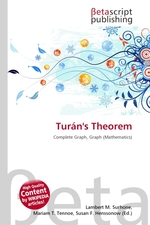Turans Theorem
Lambert M. Surhone, Miriam T. Timpledon, Susan F. Marseken
бумажная книга
High Quality Content by WIKIPEDIA articles! In graph theory, Turan's theorem is a result on the number of edges in a Kr+1-free graph. An n-vertex graph that does not contain any (r + 1)-vertex clique may be formed by partitioning the set of vertices into r parts of equal or nearly-equal size, and connecting two vertices by an edge whenever they belong to two different parts. We call the resulting graph the Turan graph T(n,r). Turan's theorem states that the Turan graph has the largest number of edges among all Kr+1-free n-vertex graphs. Turan graphs were first described and studied by Hungarian mathematician Paul Turan in 1941, though a special case of the theorem was stated earlier by Mantel in 1907.
Данное издание не является оригинальным. Книга печатается по технологии принт-он-деманд после получения заказа.


